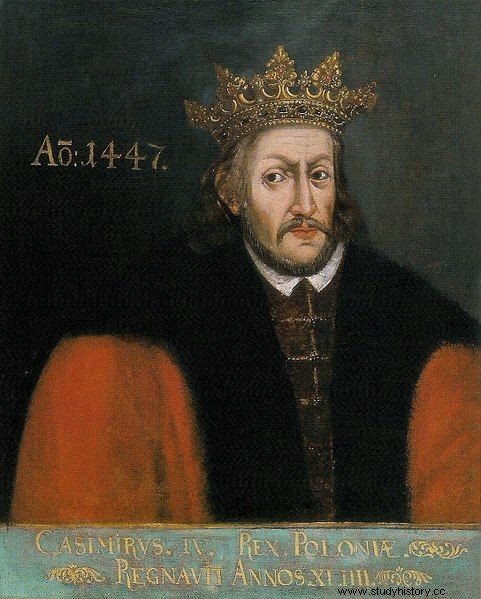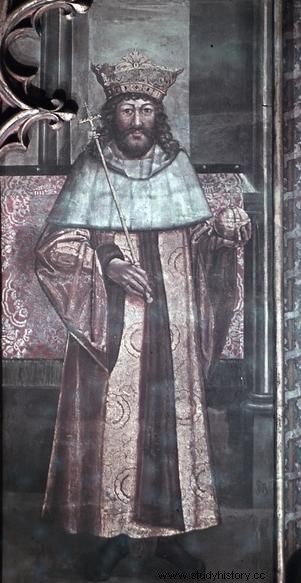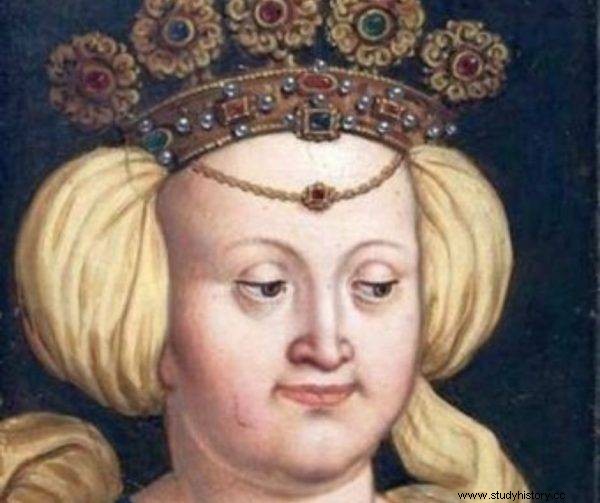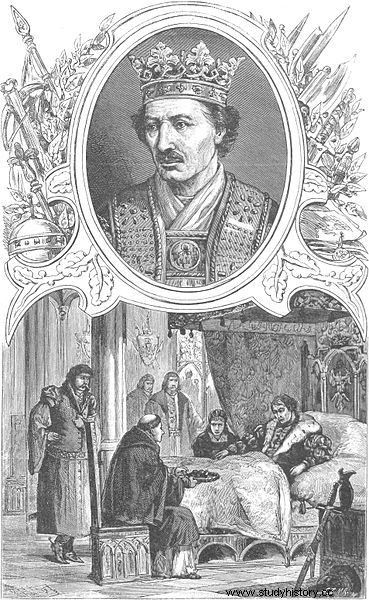Although Elżbieta Rakuszanka was not very beautiful and did not have much to say in political matters, historians consider her one of the most fulfilled (and happy) Polish rulers. Well, she finally did her marriage duty - and more than that. She gave birth to 13 children to Jagiellonian, including four kings, a cardinal and ... a saint.
As one of the few Polish rulers, she experienced sincere, unforced marriage love. By the way, it turned out to be ... extremely fertile. The effect of this was such that Elżbieta Rakuszanka was either pregnant or in childbirth for most of her life.
It is surprising that despite a serious childhood illness and numerous ailments that later accompanied her, she managed to happily give birth to thirteen descendants (of which eleven lived to adulthood, which in itself can be considered quite an achievement). Interestingly, she was not a record holder - the most (fourteen) children among our queens were born to the wife of August III the Saxon, Maria Józefa. However, it was Rakushanka - rightly so - that was called the mother of kings.
The face looks like no one else
Born between 1436 and 1439 (the exact date is not known) as the third child of the German and Hungarian King Albrecht II Habsburg, Elizabeth, as a little girl, became involved in great politics. And not only because an old astrologer had foretold her :"Your womb will bear the rulers of Europe" ...
Although she probably did not care about the nuances of the competition for the crown, they were to decide about her life. In February 1454, at the age of 17, the princess, descended from the Habsburg family, was married to the Polish king Kazimierz Jagiellończyk.

Casimir IV the Jagiellonian
The marriage, which ultimately lasted as long as 38 years and was undoubtedly one of the happiest in the history of our rulers, was close to not taking place at all. Why? Well, Rakuszanka - to put it mildly - did not sin with beauty. In the only preserved portrait, she was depicted as a petite blonde with a chubby face, slightly bulging eyes, and a lower lip protruding forward, characteristic of the Habsburgs. Karolina Stojek-Sawicka reports:
The source descriptions and what was found on the basis of the skeleton examination were even less favorable to the queen.
She probably had such a severe malocclusion that her front teeth protruded forward. Rakuszanka's silhouette (...) was severely deformed due to a strong curvature of the spine. Its axis resembled the letter "S", which caused the head to tilt towards the right shoulder. (...) Her face was also distorted, because the left half was less developed than the right one.
In view of the above, it is hardly surprising that the messenger sent by Kazimierz Jagiellończyk diplomatically stated that the candidate for a wife:"she was almost unlike in her face and growth".
And they lived happily ever after…
It is also impossible to blame the young king for hearing whatever he was scared of (he even considered sending his fiancée away with a receipt). Ultimately, however, the raison d'état was more important than aesthetic matters, and the marriage was concluded. It turned out to be quite successful, which was not at all obvious in the case of political relationships.
Piotr Węcowski emphasizes:"Kazimierz was a monogamous ruler, there are no traces of his spectacular romances in the sources." Moreover, the queen's spiritual and intellectual qualities apparently made up for her beauty deficiencies. In any case, the couple fell in love with a sincere and strong love, the best proof of which was the number of children they had.

Władysław Jagiellończyk
The first son - Władysław - was born two years after the wedding. Later, more descendants appeared at annual and sometimes two-year intervals. Thirteen in total. The last daughter (also Elżbieta) was born to Rakuszanka at the age of 47, so she had to be truly healthy. Just like the little Jagiellons she gave birth to. Mirosław Maciorowski lists:
Two of the seven daughters died in childhood, but the rest of Kazimierz married well, mainly to various German princes. The eldest son Władysław became the king of Bohemia and Hungary, the younger ones - Jan Olbracht, Aleksander and Zygmunt - the kings of Poland, the youngest Fryderyk - the cardinal and primate of Poland, and Kazimierz, who died prematurely, was declared a saint. Nice result!

In terms of securing the dynastic interest, Rakuszanka had nothing to accuse herself of. And her husband appreciated it - and nurtured family relationships. As Piotr Węcowski recounts:
Kazimierz almost always traveled with the Queen and the children. But when he rode north, where it might have been less safe, she stayed in the center of the country, though not far away. After settling matters, the king returned for his wife and they were on their way together, e.g. to Lithuania.
At the turn of the 70s and 80s of the 15th century, they spent as many as five years there with their children, they were rarely in Kraków. This shows the relationship between them:his wife, daughters and sons were almost always with him.
Silent Queen
The constant presence of Rakuszanka at the side of Kazimierz, although it undoubtedly contributed to the impressive result of the royal couple's fertility, did not translate into her existence in the political life of the country. Historian Aleksander Gieysztor assessed that the main ambition of the ruler was to place her sons on the thrones of neighboring countries and to marry her daughters in the best possible way.
Piotr Węcowski is of a similar opinion, emphasizing:
Elizabeth was the king's support. It happened that during secret negotiations she would translate to him from German. She did not have a high political position, but she probably tried to play a role. There is a known letter from Kazimierz to Gdańsk townspeople, in which he forbade them to obey her orders when the queen wanted to support someone for some office. Kazimierz could not allow his wife to be so greedy.
As a result, as a Polish ruler, Rakuszanka was primarily concerned with what - as history has shown - she could do best:giving birth and raising kings. The proud monarch (she bragged all her life that she came from "a great family of emperors") felt so confident in this field that at the age of 66 she was to write to her son Władysław, who was waiting for an heir, a letter that was in fact a treatise "De institutione regii Peri "(" The Education of a Royal Child "). She instructed the firstborn:
It is therefore necessary to give the prince the most honest nurser and the best and most educated educator so that he can learn good manners from him, such as the art of writing and grammar (...). Let him listen to the Holy Mass every day, let him be moderate and restrained in his food, devote himself to teachings in the early morning, devote himself to body exercises, avoid idleness and laziness, never listen to the sweet words of flatterers.

Kazimierz Jagiellończyk in the series Images of Polish princes and kings by Ksawery Pillati from 1888
Even in retrospect, her advice makes sense. Elżbieta only made a mistake about one thing - Władysław did not have his dream son, and a little daughter, Anna.
At the end of her life, fate was not so kind to Rakuszanka. She not only outlived her husband, but also her three sons. This personal tragedy must have had an impact on her condition. Kinga Stojek-Sawicka reports:
The queen finally got sick. Its course was short, but unfortunately fatal. Perhaps Elżbieta was mentally depressed by the unexpected death of her favorite and most promising son - Jan Olbracht.
The mother of kings passed away from this world on August 30, 1505 at the very advanced - for those times - age of seventy. She was buried next to her beloved spouse and her deceased daughters (also Elżbiet) at Wawel. She left behind a remarkable legacy:a mighty dynasty that, at its peak, ruled over vast parts of Europe. It is possible that the history of our continent would have taken a completely different course if Rakuszanka's grandson, Zygmunt August, had turned out to be as prolific as his famous grandmother ...
Bibliography:
- U. Borkowska, The Jagiellonian Dynasty in Poland, PWN 2011.
- M. Duczmal, Jagiellons. Biographical lexicon, Wydawnictwo Literackie 1996.
- M. Maciorowski, B. Maciejewska, Rulers of Poland. A story told anew, Agora 2018.
- K. Stojek-Sawicka, Plagi Królewskie, Bellona 2018.
